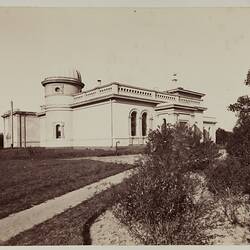In 1907 Adelaide-born scientist Walter Geoffrey Duffield, then studying in England, proposed that a solar observatory be established in Australia, to undertake research on the physics of the sun. An Australian observatory would complement northern hemisphere observatories and provide better observations through the northern hemisphere winter. The Commonwealth Government, responsible for astronomy under the Australian Constitution, indicated a willingness to consider an observatory near the proposed federal capital.
An Australian Solar Physics Committee was established by Australian scientists in 1909 to continue to press for the project to be funded, and James Oddie of Ballarat offered his 9 inch refractor by Grubb for the proposed observatory. Victorian Government Astronomer Pietro Baracchi took delivery of the Oddie refractor, oversaw its repair at Melbourne Observatory, then established a temporary observatory on Mount Stromlo, near the site of the proposed capital, to test the suitability of the site.
Baracchi and his assistant astronomer Joseph Baldwin from Melbourne Observatory travelled monthly to Mount Stromlo for a week at a time, to undertake observations with the telescope. From September 1911 to late 1912 Baracchi and Baldwin took turns to travel to Mount Stomlo. They made test observations of the sun and planets, double stars and deep sky objects such as Alpha Centauri, Rigel, Kappa Crucis, Omega Centauru, 47 Tucana, Eta Carina, 30 Doradus, Theta Orionis and the Magellanic Clouds.
World War I would delay the establishment of a permanent observatory, and the Commonwealth Solar Observatory was not established until 1923, with Duffield as its director.
References:
Frame, Tom & Faulkner, Don (2003). Stromlo: An Australian Observatory, Sydney: Allen & Unwin.
More Information
-
Keywords
-
Authors
-
Article types

